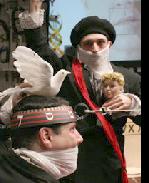SITE GUIDE
SEARCH
REVIEWS
FEATURES
NEWS
Etcetera and
Short Term Listings
LISTINGS
Broadway
Off-Broadway
NYC Restaurants
BOOKS and CDs
OTHER PLACES
Berkshires
London
California
New Jersey
DC
Philadelphia
Elsewhere
QUOTES
TKTS
PLAYWRIGHTS' ALBUMS
LETTERS TO EDITOR
FILM
LINKS
MISCELLANEOUS
Free Updates
Masthead
Writing for Us
A CurtainUp Review
Wake Up Mr. Sleepy! Your Unconscious Mind is Dead!
|
It's broken and it can't be fixed. Tick tock. Tick tock.
—Wake Up Mr. Sleepy! Most theater depicts people navigating the currents of everyday life. I admit I find this suffocating and non-revelatory. —Richard Foreman |

Joel Israel and Chris Mirto
in Wake Up Mr. Sleepy!
(Photo: Paula Court)
|
Mind you, Foreman's brand of predictability is still like no one else's. He is still very much an island unto himself. Long ago he determined that since no one else was producing the kind of theater he wanted to see, he would do it himself. And he has, for almost forty years. With each passing year, however, his shows become more and more like a caricature of themselves: Take one small downtown non-traditional space. Add kooky props, some string bisecting the stage, bizarre sound effects and a few gaily if strangely costumed actors. Mix in one non-linear, non-story-based script. Rehearse and serve.
Wake Up Mr. Sleepy! Your Unconscious Mind is Dead, ihis latest offering, "postulates the invention of the airplane as the death knell of the unconscious mind." This may very well be so, though there is no evidence of that in the production. Perhaps after seeing Foreman's last seven shows I yearn for something more psychologically engaging.
Whether Foreman has ceased to generate new ideas and has begun to rely too heavily on his old standbys or that he's simply been a New York theater staple for so long that we all now know what to expect, begs this question: Can you still be considered radical if the Times reviews you on a regular basis?
At any rate, the invention of the airplane doesn't seem to have killed off Foreman's unconscious. It's still alive and ticking. Wake Up Mr. Sleepy! does indeed "explore" the unconscious mind, but no more so than any of his other plays. That being said, it's more thematically organized than most.
Foreman's plays so often resemble the weirdly hallucinatory dreams of a mental patient (sometimes one on a bad lithium trip). He has recently begun incorporating film into his plays, which has given his last two a much-needed shot in the arm. Aside from the dangling airplane piloted by a horde of plastic baby dolls, the film segments, shot in a functioning mental hospital in Lisbon as the second part of Foreman's Bridge Project, are the best part of Wake Up Mr. Sleepy! They are basically a series of mildly disconcerting tableaux, but Foreman knows that humans are inevitably drawn to moving pictures. He plays up this dichotomy. Unable to maintain focus on either stage or film, the actors, like the audience, are pulled to the big screen as Foreman forces them to split their focus with loud sound effects and bright lights. The stage actors don't speak—only the filmed actors do.
The inherent tension between the stage and the film (exploited to such advantage with live screenings of The Rocky Horror Picture Show) is what holds this show together. While most Foreman showslack a focal center and barrage the audience with disconnected visual and auditory morsels, , Wake Up Mr. Sleepy! concentrates on exploring that tension. The stage is less cluttered than usual, and the actors use far fewer props. Compared to previous Foreman plays, it's almost restful.
Audiences would do best to follow Foreman advice in the program: "Relax! Do not work overly hard trying to understand." While his shows usually follow a certain unique formula, Wake Up Mr. Sleepy! seems to be the beginning of a departure for Foreman—more centered, and, yes, moreinteresting. He's definitely found a new talent as a film director. Let's hope it's the beginning of a trend.
| Wake Up Mr. Sleepy! Your Unconscious Mind is Dead! Written, directed and designed by Richard Foreman Cast: Joel Israel (Tall Man), Chris Mirto (Short Man), Stefanie Neukirch (Girl in Pantsuit), James Peterson (Aviator), Stephanie Silver (Girl in Skirt), Kate Manheim (Female Voice) and Richard Foreman (Male Voice) Running Time: One hour and five minutes, with no intermission Ontological Theater at St. Mark's Church, 2nd Avenue and 10th Street, 212-352-3101 From 1/18/07 to 4/01/07; opened 1/25/07 Tuesday, Thursday, Friday, Saturday, and Sunday at 8 pm; Tickets: Adults $23, Students $17, Saturday seats $28 Reviewed by Jenny Sandman based on February 13th performance |

Easy-on-the budget super gift for yourself and your musical loving friends. Tons of gorgeous pictures.

Leonard Maltin's 2007 Movie Guide

At This Theater
Leonard Maltin's 2005 Movie Guide

 >
>

